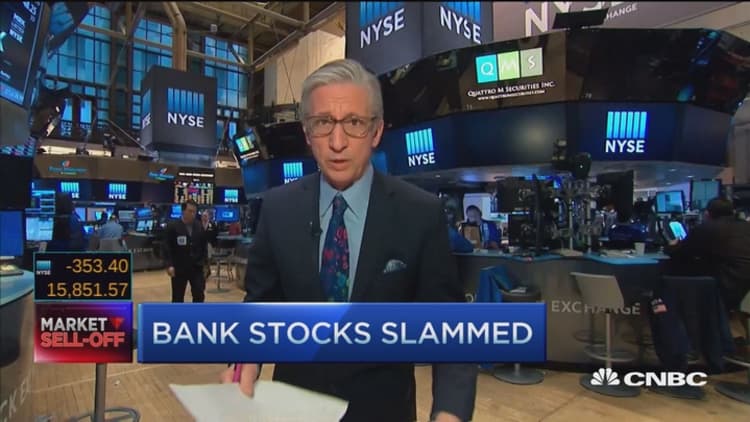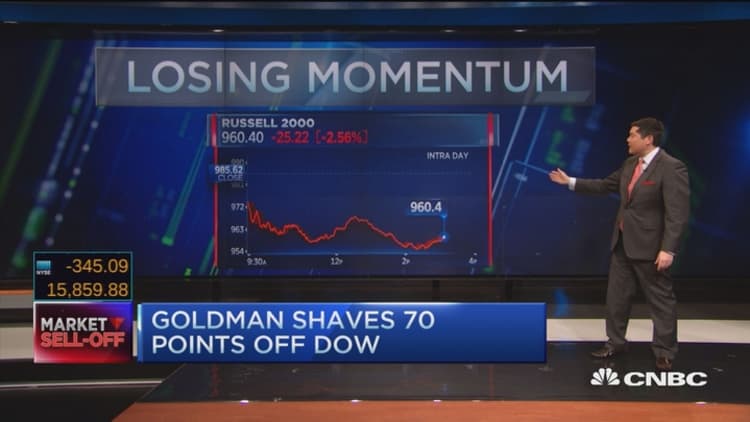


Along with the VIX, the fear factor is rising on Wall Street and that could play a role in Tuesday's trading.
Stocks were spooked Monday, and the Dow fell as much as 400 points as traders pointed to a multitude of woes weighing on the market psyche. Gold and Treasurys became islands of safety.
The Dow closed off its lows after a turnaround in oil sent energy stocks higher in afternoon trading. The blue chip index lost 177 points to 16,027, and the slumped 1.4 percent to 1,853. The CBOE's Volatility Index, which measures activity in puts and calls on the S&P 500, rose 11 percent to 26.
"It's fear. I think one of the overriding factors right now is this fear. You see it in the VIX. You see it in the corporate bond spreads. You see it in asset flows. You see it in money coming out of equities, and in all of the usual spots where you would see fear," said John Kosar, chief market strategist at Asbury Research. "What I say is basically driving the bus right now — is fear."
Slowing global growth has been nagging at markets, but then so has the idea that the energy industry's slump will create casualties among energy companies and the banks that lent to them. European banks are especially vulnerable to this idea, and they have already been suffering the most. Deutsche Bank was down 8 percent Monday, while U.S. institutions in the XLF financial ETF fell 2.5 percent.
Read MoreBuybacks could be the stock market savior this year
"The new flavor of the day is the banks," said George Goncalves, head of rate strategy at Nomura. Negative yields in Europe and in Japan have been a factor worrying markets.
"If they keep pushing yields lower and lower, like what is happening in (overseas) markets, how are these banks going to make any money," he said. "It feels circular. The lower we go in rates the worst it is for the financial system."
Goncalves said the odds of a Fed rate hike have decreased. Fed funds futures on Monday were pricing in a next to zero chance for the March meeting, and just above a 50 percent chance for a rise way out in February 2017. "There's concerns about credit quality, and concerns about what's happening in Europe. We're throwing out everything with the European bath water," said Goncalves. "Everything is under stress today."
Stocks were slammed as bond spreads widened and the market worried a major energy company would head into bankruptcy this year. Rumors circulated that Chesapeake Energy would file for bankruptcy, but it said it has no plans to do so. Chesapeake's short-term securities expiring March 15 were trading with a yield of 324 percent but fell back to yield 210 percent after Chesapeake denied the story.
Read More The market is broken: Technician
"There's a lot of companies that people are concerned about that may file bankruptcy, but this was more Chesapeake focused. The combination of Chesapeake and weaker oil prices, I think put pressure on the entire high-yield energy market," said Marisa Moss, Citigroup director, high-yield energy research. "The fact (yields) didn't get back to where we were means people are still concerned about them making the March 16 payment. We believe they'll make the principle payment." Chesapeake has more than $1.7 billion in cash.
"We think they have all the levers to pull to continue to decrease their debt maturity schedule," she said.
Treasury yields continued to fall Monday, in a flight-to-safety bid. They are also near levels they were at when the Fed met in October and indicated it could raise rates in December.
"They were pretty hawkish in October which made us all view the Fed was in play," said Goncalves. The yield was at about 0.66 percent in late trading, and the 10-year slipped to 1.74 percent.
There is a $24 billion, three-year Treasury auction at 1 p.m. ET Tuesday. Data expected on the day include the NFIB small-business survey at 6 a.m., and wholesale trade and the JOLTs report on job openings, both at 10 a.m. Earnings are expected Tuesday morning from Coca-Cola, Viacom, Spirit Airlines, Sanofi, Wendy's, Regeneron and Ingersoll-Rand. After the bell reports are expected from Disney, Panera Bread, Nuance, Western Union, Akamai, and First Data.
The high-yield area was just one corner of the markets flashing warning signs Monday. Momentum stocks sold off sharply, and the Nasdaq spiraled lower, closer to a level where it would be officially in a bear market. If the index reaches 4,185, it would be down 20 percent and officially in a bear market. It closed about 100 points above that at 4,283, as it fell 1.8 percent Monday.
Read MoreJeremy Siegel: I was too bullish—and here's why
Facebook dropped 4.2 percent, Amazon.com fell 2.8 percent and Priceline slid 4.1 percent. The iShares Nasdaq Biotechnology ETF IBB dropped 3.2 percent.
"I think investors are dumping momentum stocks because they want to lock in gains in a category that still has gains," said Sam Stovall, chief U.S. equity strategist at S&P Capital IQ.
Jonathan Golub, UBS' chief U.S. market strategist, said investors may be cautious, but they would do better in the market if they were to buy while volatility is high. "The best return you get is when the VIX is over 25, not when the VIX is at 15," he said.
Read MoreContrarian Street call: Bet on a weak dollar
"What you really have is the materials, industrials and energy sectors are a genuine mess but the other 80 percent of the market is really on solid footing. In terms of earnings, the companies that are beating estimates are doing quite well," he said.
Golub said he's confident that in two to three months, investors would be rewarded if they put money into the market while investors are fearful.
Kosar said so far the S&P has stayed in a range between the low from January and the Feb. 1 high of 1,947. But analysts are waiting to see if the S&P can hold 1,820, and many expect to see a retest of the 1,812 intraday low of January.
"Until the market becomes less fearful, rallies are going to be short-lived," he said.


